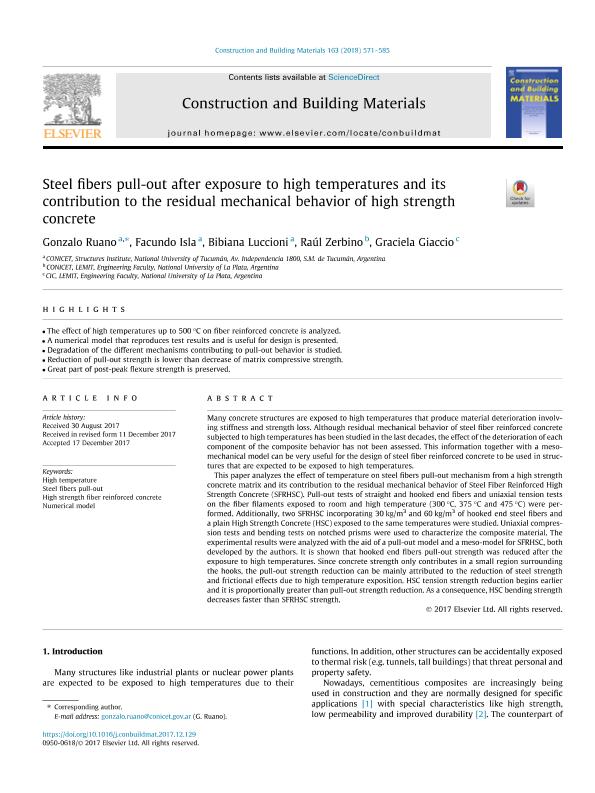Mostrar el registro sencillo del ítem
dc.contributor.author
Ruano Sandoval, Gonzalo Javier

dc.contributor.author
Isla Calderón, Facundo Andrés

dc.contributor.author
Luccioni, Bibiana Maria

dc.contributor.author
Zerbino, Raul Luis

dc.contributor.author
Giaccio, Graciela Marta

dc.date.available
2020-03-16T21:00:00Z
dc.date.issued
2018-02
dc.identifier.citation
Ruano Sandoval, Gonzalo Javier; Isla Calderón, Facundo Andrés; Luccioni, Bibiana Maria; Zerbino, Raul Luis; Giaccio, Graciela Marta; Steel fibers pull-out after exposure to high temperatures and its contribution to the residual mechanical behavior of high strength concrete; Elsevier; Construction And Building Materials; 163; 2-2018; 571-585
dc.identifier.issn
0950-0618
dc.identifier.uri
http://hdl.handle.net/11336/99704
dc.description.abstract
Many concrete structures are exposed to high temperatures that produce material deterioration involving stiffness and strength loss. Although residual mechanical behavior of steel fiber reinforced concrete subjected to high temperatures has been studied in the last decades, the effect of the deterioration of each component of the composite behavior has not been assessed. This information together with a meso-mechanical model can be very useful for the design of steel fiber reinforced concrete to be used in structures that are expected to be exposed to high temperatures. This paper analyzes the effect of temperature on steel fibers pull-out mechanism from a high strength concrete matrix and its contribution to the residual mechanical behavior of Steel Fiber Reinforced High Strength Concrete (SFRHSC). Pull-out tests of straight and hooked end fibers and uniaxial tension tests on the fiber filaments exposed to room and high temperature (300 °C, 375 °C and 475 °C) were performed. Additionally, two SFRHSC incorporating 30 kg/m3 and 60 kg/m3 of hooked end steel fibers and a plain High Strength Concrete (HSC) exposed to the same temperatures were studied. Uniaxial compression tests and bending tests on notched prisms were used to characterize the composite material. The experimental results were analyzed with the aid of a pull-out model and a meso-model for SFRHSC, both developed by the authors. It is shown that hooked end fibers pull-out strength was reduced after the exposure to high temperatures. Since concrete strength only contributes in a small region surrounding the hooks, the pull-out strength reduction can be mainly attributed to the reduction of steel strength and frictional effects due to high temperature exposition. HSC tension strength reduction begins earlier and it is proportionally greater than pull-out strength reduction. As a consequence, HSC bending strength decreases faster than SFRHSC strength.
dc.format
application/pdf
dc.language.iso
eng
dc.publisher
Elsevier

dc.rights
info:eu-repo/semantics/openAccess
dc.rights.uri
https://creativecommons.org/licenses/by-nc-sa/2.5/ar/
dc.subject
HIGH STRENGTH FIBER REINFORCED CONCRETE
dc.subject
HIGH TEMPERATURE
dc.subject
NUMERICAL MODEL
dc.subject
STEEL FIBERS PULL-OUT
dc.subject.classification
Ingeniería de la Construcción

dc.subject.classification
Ingeniería Civil

dc.subject.classification
INGENIERÍAS Y TECNOLOGÍAS

dc.title
Steel fibers pull-out after exposure to high temperatures and its contribution to the residual mechanical behavior of high strength concrete
dc.type
info:eu-repo/semantics/article
dc.type
info:ar-repo/semantics/artículo
dc.type
info:eu-repo/semantics/publishedVersion
dc.date.updated
2020-03-12T18:45:07Z
dc.journal.volume
163
dc.journal.pagination
571-585
dc.journal.pais
Países Bajos

dc.journal.ciudad
Amsterdam
dc.description.fil
Fil: Ruano Sandoval, Gonzalo Javier. Consejo Nacional de Investigaciones Científicas y Técnicas; Argentina. Universidad Nacional de Tucumán. Facultad de Ciencias Exactas y Tecnología. Instituto de Estructuras "Ing. Arturo M. Guzmán"; Argentina
dc.description.fil
Fil: Isla Calderón, Facundo Andrés. Consejo Nacional de Investigaciones Científicas y Técnicas; Argentina. Universidad Nacional de Tucumán. Facultad de Ciencias Exactas y Tecnología. Instituto de Estructuras "Ing. Arturo M. Guzmán"; Argentina
dc.description.fil
Fil: Luccioni, Bibiana Maria. Consejo Nacional de Investigaciones Científicas y Técnicas; Argentina. Universidad Nacional de Tucumán. Facultad de Ciencias Exactas y Tecnología. Instituto de Estructuras "Ing. Arturo M. Guzmán"; Argentina
dc.description.fil
Fil: Zerbino, Raul Luis. Universidad Nacional de La Plata. Facultad de Ingeniería; Argentina. Consejo Nacional de Investigaciones Científicas y Técnicas; Argentina
dc.description.fil
Fil: Giaccio, Graciela Marta. Universidad Nacional de La Plata. Facultad de Ingeniería; Argentina. Consejo Nacional de Investigaciones Científicas y Técnicas; Argentina
dc.journal.title
Construction And Building Materials

dc.relation.alternativeid
info:eu-repo/semantics/altIdentifier/url/https://www.sciencedirect.com/science/article/pii/S0950061817325345
dc.relation.alternativeid
info:eu-repo/semantics/altIdentifier/doi/http://dx.doi.org/10.1016/j.conbuildmat.2017.12.129
Archivos asociados
